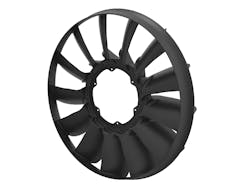Horton Inc. is introducing a new portfolio of products to help on-highway truck manufacturers meet higher engine cooling system demands and stringent CO2 emissions standards. The new products include the HS11A, HS6 and RS Series fans, and the LCX Series fan drives.
Both HS11A and HS6 fans feature decreased blade areas, thereby allowing freer ram air to circulate through tightly-packed engine compartments for cooling purposes. Yet, when required, their innovative blade profiles provide the increased flow and pressure required by the cooling systems in high- performance, medium- and heavy-duty trucks. The fans are also durable and lightweight. The combination of performance and design reduces the parasitic draw on the engine, reducing fuel consumption and related emissions while also decreasing noise.
The LCX Series is based on Horton’s proven variable-speed fan drive design which more precisely matches engine cooling demands. Benefits include reduced fuel consumption (and thereby emissions), decreased noise and less parasitic draw on the engine. The LCX Series enhances these benefits even further with three new features: superior low-speed controllability, enhanced low off speed and Cold- Start Disengagement (CSD).
Low-speed controllability allows the drives to accommodate moderate cooling needs such as those associated with air conditioning condenser cooling. The benefit is more precise fan control across all speeds which increases fuel economy and thereby reduces emissions. Low-speed controllability also increases available horsepower and reduces noise given more precise fan-speed control. The LCX Series’ low off-speed ensures that little energy is consumed by fan rotation when cooling is not needed. Cold-Start Disengagement technology disengages the LCX Series fan drives faster than competitive products, allowing engines and cabs to warm-up faster during cold weather starts.
“Horton is looking forward to securing a leadership position in the European on-highway truck market,” said Cordell Dietz, president and CEO at Horton. “Together, with our recent significant investments in engineering capability and manufacturing capacity in our European operations, these innovative new fans and drives are a testament to our commitment. We are confident that our solutions will help our European customers meet demanding engineering and environmental challenges without compromising vehicle performance.”




